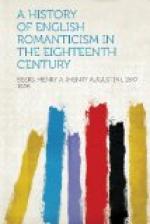poetry, whatever, in his secret heart, he might have
thought.[1] To Johnson such an opinion must have seemed
flat blasphemy. Hurd accounts for the contempt
into which the Gothic had fallen on the ground that
the feudal ages had never had the good fortune to
possess a great poet, like Homer, capable of giving
adequate artistic expression to their life and ideals.
Carent vate sacro. Spenser and Tasso,
he thinks, “came too late, and it was impossible
for them to paint truly and perfectly what was no
longer seen or believed. . . As it is, we may
take a guess of what the subject was capable of affording
to real genius from the rude sketches we have of it
in the old romancers. . . The ablest writers
of Greece ennobled the system of heroic manners, while
it was fresh and flourishing; and their works being
masterpieces of composition, so fixed the credit of
it in the opinion of the world, that no revolution
of time and taste could afterward shake it. Whereas
the Gothic, having been disgraced in their infancy
by bad writers, and a new set of manners springing
up before there were any better to do them justice,
they could never be brought into vogue by the attempts
of later poets.” Moreover, “the
Gothic manners of chivalry, as springing out of the
feudal system, were as singular as that system itself;
so that when that political constitution vanished
out of Europe, the manners that belonged to it were
no longer seen or understood. There was no example
of any such manners remaining on the face of the earth.
And as they never did subsist but once, and are never
likely to subsist again, people would be led of course
to think and speak of them as romantic and unnatural.”
Even so, he thinks that the Renaissance poets, Ariosto
and Spenser, owe their finest effects not to their
tinge of classical culture but to their romantic materials.
Shakspere “is greater when he uses Gothic manners
and machinery, than when he employs classical.”
Tasso, to be sure, tried to trim between the two,
by giving an epic form to his romantic subject-matter,
but Hurd pronounces his imitations of the ancients
“faint and cold and almost insipid, when compared
with his original fictions. . . If it was not
for these lies [magnanima mensogna] of
Gothic invention, I should scarcely be disposed to
give the ’Gierusalemme Liberata’ a second
reading.” Nay, Milton himself, though finally
choosing the classic model, did so only after long
hesitation. “His favorite subject was
Arthur and the Knights of the Round Table. On
this he had fixed for the greater part of his life.
What led him to change his mind was partly, as I
suppose, his growing fanaticism; partly his ambition
to take a different route from Spenser; but chiefly,
perhaps, the discredit into which the stories of chivalry
had now fallen by the immortal satire of Cervantes.
Yet we see through all his poetry, where his enthusiasm
flames out most, a certain predilection for the legends




